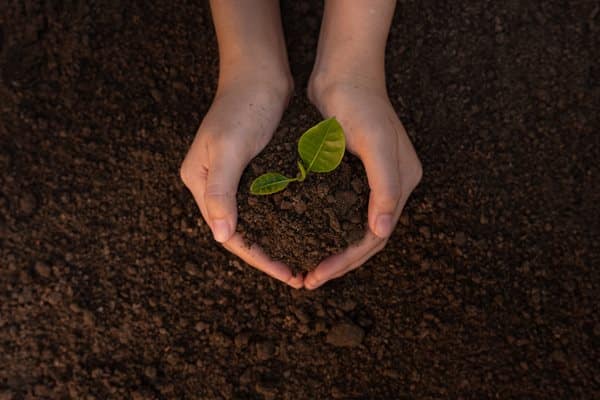Home / Information & advice / Topsoil & compost / Improving your soil / Supporting soil health – things we all need to know about soil
Society is increasingly aware of the need to protect our own health and that of the environment. This awareness has led to concentrated efforts to improve issues such as recycling, the sustainability and safety of food packaging and emissions, as well as to increase responsible energy and food production.
But protecting the very ground we walk on could be as valid as any of those topics.
According to the Soil Association’s ‘Save our Soil’ campaign, the preservation of soil and its health is vital to the preservation of the human race. The good news is, it is something we can all actively contribute to, starting in our own back gardens.

Without really realising it, soil plays a significant role in our lives. Not only does it contribute to our enjoyment of life but it is also central to global health and well being, in addition to the stability of our eco-systems.
Soil is the basis for food production – the world needs topsoil to grow 95% of its food.1
Soil is also the foundation of the countryside, parks, sports grounds and gardens from which we get so much enjoyment and exercise, aiding both our physical and mental health.
Vitally, both global and local ecosystems depend upon soil health.
Among the many benefits of well-conditioned soil, the following are key:
Much of what we do as a race is having a detrimental effect on the very existence of soil.
The necessary activities of food production and housing are contributing to the changing structure of the earth’s top layer, topsoil, limiting its ability to sequester carbon and hold the nutrients needed for plant life.
In the BBC Ideas video ‘Why soil is one of the most amazing things on Earth’ it explains that it takes more than 100 years to build just 5mm/0.5cm of soil but just moments for it to be destroyed. We are actually losing soil 50 to 100 times faster than it is able to rebuild.
In fact, according to Maria-Helena Semedo of the UN’s Food and Agriculture Organization, we are in danger of running out of topsoil in around 60 years if we continue to degrade it at the current rate.1
Maintaining the health of the soil in our own gardens and allotments and growing our own produce is the best place to start. Here are some examples of ways you can help support soil health locally:
Home composting
Aside from reducing the amount of waste going to landfill, home composting creates nutrient-rich compost or ‘soil improver’ by breaking down organic waste, such as fruit and vegetable peelings, garden trimmings and grass clippings. As well as making the soil more productive and reducing the need for chemical fertilisers, the added organic material assists with moisture retention.
Select peat-free compost
If you choose not to compost, or if you need to supplement what you make, then purchasing a peat-free variety will help preserve what is one of the earth’s biggest carbon stores, also preventing the escape of carbon dioxide into the atmosphere that occurs as peat is harvested.
No-dig gardening
As the ground is worked for food production, carbon dioxide is released and the structure of the soil is altered. The no-dig method of gardening prevents land from being over-worked and helps to introduce more organic matter which rebuilds the structure of the soil.
Use of cover crops
These are crops that are planted between harvested crops to cover what would otherwise be bare earth. They help to prevent soil erosion by protecting the ground from heavy rainfall and helping to absorb excess water then improving the soil structure and nutrient levels as they break down.
Grow soil-friendly plants
Soil fertility can be improved by plants that extract nitrogen from the air. Deep-rooted plants help by alleviating soil compaction and passing nutrients from deeper in the ground up to more shallow rooted plants.
Reinstate natural lawns
Where lawns have been replaced with patios or artificial grass, there can be an excess of water run off onto surrounding ground which can wash away the top layer of soil. Reinstating lawns helps to prevent localised flooding. Not only that, but natural lawns absorb CO2 and generate oxygen.
Buy organic
If you aren’t able to create your own compost and follow the advice above, then consider adapting your buying habits. Organic produce is cultivated without the use of chemical fertilisers and pesticides which are detrimental to soil health.
Choose responsibly sourced topsoils
When you need to import topsoil from a third party, buying from an environmentally friendly supplier who uses responsible sourcing protocols will help to ensure that you are limiting your impact on the environment. Find out more about choosing and using suitable topsoil in our Topsoil Buying Guide, or by watching our ‘Selecting the right topsoil’ video.
While this isn’t an exhaustive list of actions you can take, it is a realistic starting point for many of us.
At Rolawn, we are committed to lessening our impact on the environment, with ISO certification for our Environmental Management Systems (BS EN ISO 14001:2015) and independent awards for the continual progression we make in the area. As part of this, one of our objectives is to provide our customers and followers with the resources to make informed decisions about actions and purchases which align with our aim to limit environmental impact.
You can find further information about soil health and ways to protect it from the following sources:
BBC Ideas
British Society of Soil Science
Soil Association
Tim O’Hare – Soil science and landscape engineering consultants
The Environment Agency